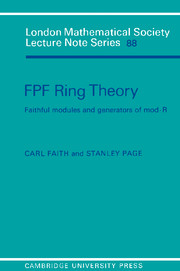Book contents
- Frontmatter
- Contents
- Preface
- Dedication and Acknowledgement
- Introduction
- Chapter 1 The Basics
- Chapter 2 Noncommutative Semiperfect and Semiprime
- Chapter 3 Nonsingular FPF rings
- Chapter 4 Goldie Prime FPF Rings with RRM and the Structure of Noetherian Prime FPF Rings
- Chapter 5 Self-Injective FPF Rings, Thin Rings and FPF Group Rings
- Summary of the Structure of FPF Rings
- Open Questions
- Bibliography
- Abbreviations and Symbols
- Index
Chapter 3 - Nonsingular FPF rings
Published online by Cambridge University Press: 05 April 2013
- Frontmatter
- Contents
- Preface
- Dedication and Acknowledgement
- Introduction
- Chapter 1 The Basics
- Chapter 2 Noncommutative Semiperfect and Semiprime
- Chapter 3 Nonsingular FPF rings
- Chapter 4 Goldie Prime FPF Rings with RRM and the Structure of Noetherian Prime FPF Rings
- Chapter 5 Self-Injective FPF Rings, Thin Rings and FPF Group Rings
- Summary of the Structure of FPF Rings
- Open Questions
- Bibliography
- Abbreviations and Symbols
- Index
Summary
In this chapter we study nonsingular FPF rings. For commutative rings we have: If R is FPF, then Qc = Qcl(R) is FPF, Faith [78, Th. C]. For general noncommutative rings the question remains open. In case R is right nonsingular or semiprime we show that Qm = Qrmax(R) is FPF (both sides) if R is FPF (one side). In fact, under these circumstances we give a complete description of Qm(R) as a regular ring of bounded index. Using this description we are able to show prime right FPF rings are Goldie on both sides and that every right Goldie right FPF ring is left Goldie, too. We also show that right FPF rings are right semihereditary iff left semihereditary iff they and all their matrix rings are Baer rings. Finally we include some results on fully idempotent rings and in particular V-rings which are FPF.
Below and hereafter, ⊥X(resp. X⊥) denotes the left annihilator left (resp. right) ideal corresponding to a nonempty subset X of R.
PROPOSITION.
Let R be right FPF. Then:
If M is a finitely generated and faithful right R-module, then the dual module
If I and K are right ideals such that I ∩ K = 0, then ⊥IR + ⊥KR = R, and hence ⊥I + ⊥K generates R-mod. Thus, either⊥I ≠ 0, or⊥K ≠ O.
- Type
- Chapter
- Information
- FPF Ring TheoryFaithful Modules and Generators of Mod-R, pp. 58 - 94Publisher: Cambridge University PressPrint publication year: 1984

